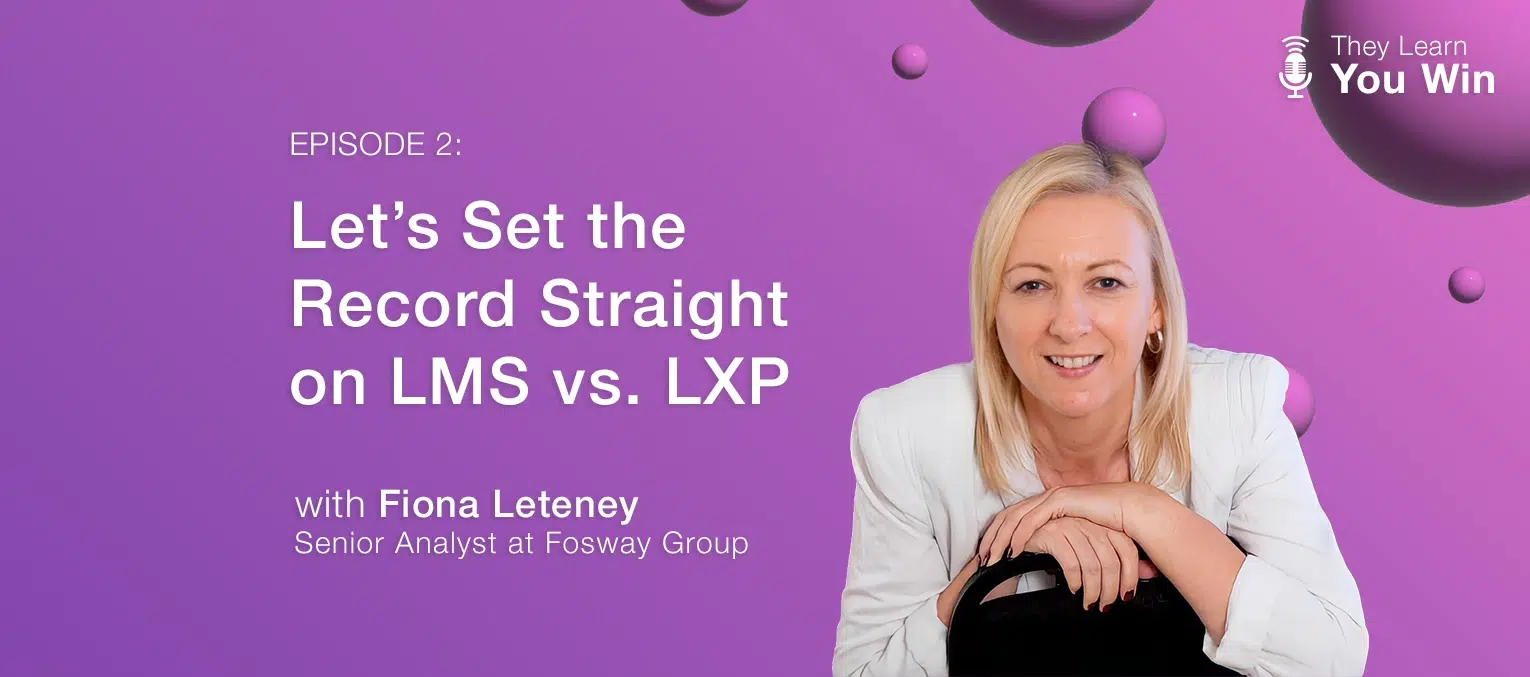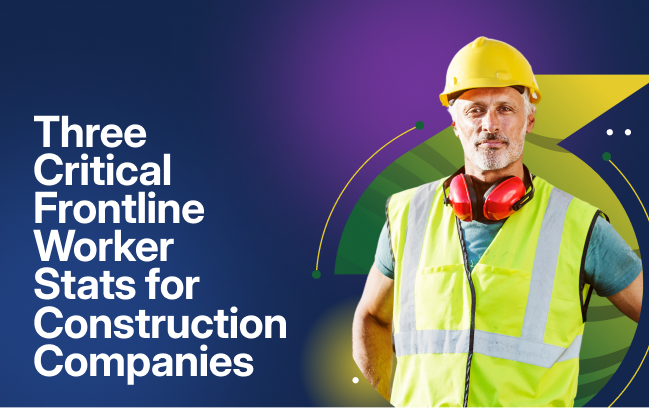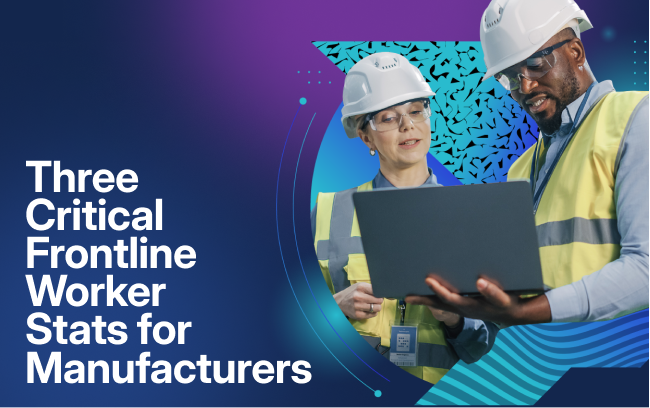January 11, 2024
8 Min. Read

The learning technology landscape is a crowded one. From learning-focused offerings available as add-ons to broader human capital management solutions to pointed software for specific learning needs, it can be challenging to decipher which solution is right for your organization.
There was once a time when organizations invariably turned to learning management software, or an LMS, to meet their learning and development goals. However, as the market matured, some providers started offering what they call “learning experience platforms” (LXPs). But is an LMS and an LXP all that different?
We invited Fiona Leteney, Senior Analyst at Fosway Group, to our podcast to find out. In episode two of They Learn, You Win, Fiona breaks down the learning technology trends she and her colleagues are seeing and dispels some myths surrounding learning management systems.
Fiona and our own David Wentworth dive deep to separate fact from fiction and signal from all the noise. When it comes to learning technology, what’s real, what isn’t, and what really counts? Take a look at the best highlights from the conversation below.
Defining “Experience”
What’s the difference between an LMS and an LXP?
“I don’t know when the ‘LXP’ label first appeared, but at Fosway, we saw this coming back in about 2017”, shares Fiona.
She adds that learning management systems were starting to get a bad reputation at the time. Outdated design and clunky user experiences left many companies disillusioned about the value of an LMS, and they quickly sought something more. The Fosway Group noticed the trend, though they weren’t sure what to make of it—so they decided to do the research.
“What we did is deconstruct what’s meant by the X in LXP. What does this experience piece look like? We talked to both vendors and corporates about what experience means to them, and we found that there are seven to eight components to it.”
Fiona Leteney, Senior Analyst at Fosway Group
Defining Buyer Needs
So, which one is better for businesses—an LMS or an LXP? Does it matter?
As they explored what “experience” means to different companies, Fiona and her team uncovered another insight: it doesn’t matter what anyone calls these platforms; what’s most important is for the buyer to thoroughly understand what they’re looking to accomplish with the technology. And they found that it varies significantly from organization to organization.
“A lot of people think it’s all about the look and feel of the platform—the UX and UI side of things—but for some companies, mobile learning, collaboration tools, skills mapping, or AI capabilities might be more important.”
Fiona Leteney, Senior Analyst at Fosway Group
Many companies turn to Fosway Group to provide a shortlist of their best learning technology options, but ultimately, it depends on how they plan to use the platform. And bigger isn’t always better for complex organizations like franchises, extended enterprises, and businesses that operate nationally or internationally.
“It’s not always about the amount of features or the functionality of an LMS. It’s about whether the provider has the capability to support large, complex, sophisticated global organizations that need specific configurations for different parts of the world, particular legal requirements, or whatever the case may be. Only certain vendors can actually deliver.”
Fiona Leteney, Senior Analyst at Fosway Group
Suites or Specialists?
There’s the idea that some companies prefer a one-stop shop for everything from core HR software to learning and more, while others opt for specialized platforms that are each great at what they do and easily connect to one another. What’s your impression of this?
One of the greatest challenges of choosing a learning system is getting all stakeholders to agree on a single solution—including those outside L&D and HR.
According to Fiona, if L&D departments have the choice, they’ll most often opt for the best-in-class system. When IT departments, finance managers, and other stakeholders get involved, though, L&D leaders feel more pressure to use the tools embedded within the broader HR systems the company already utilizes.
While that may seem more straightforward, it can create more work in the long run for some businesses. When L&D leaders discover the learning tools embedded within HCM ecosystems can’t handle vital functions like progress monitoring or compliance tracking, they often search for a specialized solution to fill the gap.
“We’re seeing that those who choose the HCM route have to add specialists to make up for the gap of what the HCM system can’t do. There’s a flux at the moment, and that tension is not going away.”
Fiona Leteney, Senior Analyst at Fosway Group
The Evolution of Learning
How are organizations thinking about learning and development? Is it changing?
It’s easy for companies to fall into the trap of thinking their LMS is the problem because it’s clunky, and if they get a new system, everything will be fixed. That’s not always the case, and a lot of hard work is often involved in figuring out how to address the challenges.
A while back, most companies just wanted a simple learning platform that “pushes” mandatory coursework like compliance training to learners. These days, though, L&D teams seek platforms that offer more of a “pull”—or incentive—for learners to explore content independently, engage with new learning opportunities to enhance skills, and determine their own learning journeys based on career goals and preferences. That’s the stuff that really builds a learning culture within an organization, according to Fiona.
She says that while it’s almost “not cool” to be on the search for an LMS, it all comes down to the company’s unique needs to determine which ones are best.
“It’s all about the buyer. Are they global? Are they local? Are they looking for a local provider? Are they looking for a great mobile app to train employees in hospitality or retail environments? Is it an extended enterprise?”
Fiona Leteney, Senior Analyst at Fosway Group
Fosway Group’s 9-Grid™ Explained
To help diverse organizations across Europe find the best learning platform for their L&D needs, Fosway Group offers the 9-Grid™, the only market analysis model that maps the relative position of solutions and providers in the learning and talent systems market.
Unlike other analyst models, all nine zones in the 9-Grid™ have value and a set of actions to maximize that value. It prompts honest conversations among stakeholders about the trade-off between customer performance, solution sophistication, and total cost of ownership.
Fiona explains how Fosway Group determines placement among the grid:
“The vertical axis refers to potential, combining a learning system’s functionality and a buyer’s needs. The lower end represents simple functionality, the middle represents average, and the top includes sophisticated systems—that’s probably where retail and hospitality buyers are looking.”
Fiona Leteney, Senior Analyst at Fosway Group
This contrasts with the horizontal axis, which is all about performance.
“How often does the system get shortlisted? How often do they win accounts? This axis also considers what customers think of the system. We don’t just talk to the vendors; we also talk to the customers to get a feel for how a provider is stepping up and whether they’re supporting the customer.”
Fiona Leteney, Senior Analyst at Fosway Group
Our conversation with Fiona Leteney is full of great insights about what should—and shouldn’t—matter to businesses searching for a learning solution. Listen to the full episode here, and be on the lookout for more episodes where we tackle the tough questions with more experts and explore the best of learning and development.



